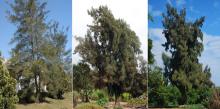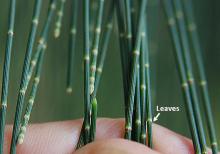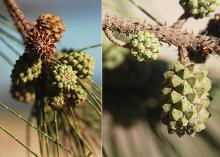Casuarina equisetifolia
Common name:
Australian Pine
Horsetair Tree
Ironwood
Beach Sheoak
Pronunciation:
kazh-yoo-ar-EYE-nuh ek-wih-set-ih-FOL-ee-uh
Family:
Casuarinaceae
Genus:
Type:
Broadleaf
Native to (or naturalized in) Oregon:
No
- An evergreen tree that superficially resembles a conifer due to the production of cone-like fruits and pine-needle-like branchlets; it is not a pine. A fast-growing tree (5-10 ft/yr or 1.5-3 m/yr) which may attain heights of 20-45 m (65-175 ft), but frequently less. Lateral branches originating low on the stem often overtake the leader, producing a very broad somewhat flat-topped mature tree. The foliage consists of slender, much-branched green to grey-green, jointed, grooved twigs 0.5–1 mm in diameter (which carry out photosynthesis), these bear scale-leaves which are seen as tiny (~ 1 mm), pointed teeth ringing a twig joint. (Foliage appears similar to that of a very different plant, Athel Tamarisk (Tamarix aphylla). The flowers are produced in small catkin-like clusters; the male flowers are in simple spikes 0.7–4 cm long, the female flowers on short stalks. Male and female flowers are produced on the same tree (i.e., monoecious). The fruit is an oval woody structure 1.0–2.5 cm long and about 1 cm in diameter; it somewhat resembles a conifer cone.
- Full sun, little to regular watering
- Hardy to USDA Zone 9 The native range extends from Burma and Vietnam throughout Malesia east to French Polynesia, New Caledonia, and Vanuatu, and south to Australia. Casuarina equisetifolia can establish on nutrient poor soils, e.g., beach sands, in part because the roots are in association with a bacteria that fix atmospheric nitrogen. It is very salt tolerant.
- It has been widely distributed throughout the world and is often considered invasive. Some regard it as the most invasive species in south Florida where it was introduced in the 1880s. It is now one of the most common trees on frost-free beaches world-wide.
- equisetifolia: with leaves like horsetail or Equisetum






